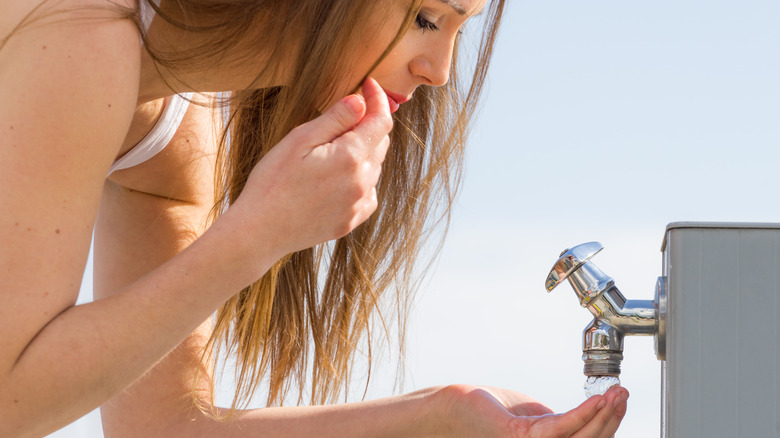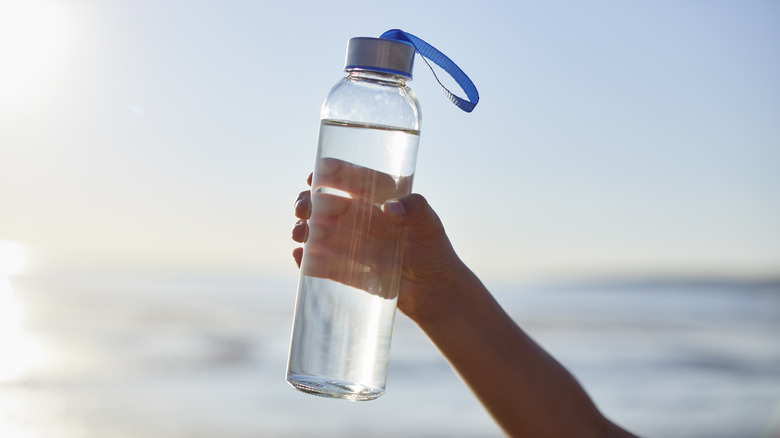Is It Actually Safe To Drink The Tap Water On Your Cruise?
When planning your dream cruise vacation, many considerations naturally come into mind, especially if it's your first time. Choosing the best cabin to stave off seasickness and figuring out the day of the week to book a cruise for maximum savings are just the start. But amidst the sea of questions (pun intended), you might overlook a seemingly mundane but important question: How safe is the tap water on a cruise ship? While you're surrounded by an ocean of undrinkable saltwater, what's the deal with the water flowing through the ship's plumbing?
Well, you'll be pleased to know that the tap water on cruise ships is sippable, chuggable, gulpable, or however else you consume your liquids. Not only is the water safe to drink, but it also adheres to rigorous standards. Major cruise lines like Royal Caribbean, Carnival, and Disney Cruises assure on their respective websites that their water on board is filtered by a portable water system that has been vetted by the Centers for Disease Control and the U.S. Public Health Service's Vessel Sanitation Program. The water that gushes from the faucet in your cabin has been through a series of inspections (twice a year, in fact), which involve the checking of halogen and pH levels to ensure it meets strict safety criteria. So really, you can rest easy knowing that the water on your cruise is as dependable as it is drinkable.
There's a lot of science behind making cruise ship water safe to drink
Interestingly, the tap water on cruises comes from seawater, so if you do drink that, you're technically drinking the water the ship is floating on. But don't worry, it doesn't reach your glass until it undergoes a thorough purification process.
Captain James of Royal Caribbean explained in a TikTok video that ships typically employ two main methods to transform seawater into perfectly drinkable water. "The first one is through reverse osmosis. "We take seawater and squeeze it with high-pressure pumps through filters and essentially filter out all the minerals in the salt water," he said. Meanwhile, the second method is akin to a giant tea kettle but on an industrial scale. "What happens is seawater is brought into huge diagonal tubes, and there it's preheated. Once it gets into the vertical piping ... that's where it's evaporated," he explained, noting that the process is not so different from when heating water at home. "We collect that steam, we funnel that off, and that's what you drink and goes into our potable water system on board." Any leftover brine is returned to the sea.
With such sophisticated technology on board, the safety of cruise tap water is beyond doubt. However, Captain James has one piece of advice: "All the water in your sinks, in your toilet, in your shower, it all comes from the same tank. It's all drinkable. Don't drink the stuff from the toilets, though."
When it doubt, you can take matters into your own hands
If the idea of sipping straight from the tap on a cruise ship still makes you feel uneasy, that's completely understandable. The CDC recommends sticking to factory-sealed water bottles as your safest best when traveling. However, remember that cruise lines have different policies regarding bringing beverages onboard. Make it a habit to look them up before joining a cruise, lest you want to leave them behind. Take Royal Caribbean, for instance. It allows guests to bring up to twelve 17-ounce bottles or cartons of non-alcoholic beverages. Disney Cruises, on the other hand, permits passengers to bring one unopened water bottle as long as it fits inside a carry-on bag. Meanwhile, Carnival does not allow guests to bring any type of beverage and offers bottled water for purchase: a 12-pack of 16.9-ounce bottles costs $14.95, an 8-pack of 50.72-ounce bottles costs $24.95, and a single 50.72-ounce bottle costs $4.50, not including delivery fees.
For an eco-friendly option, you can also consider bringing a reusable water bottle to fill at the multiple water dispensers and beverage stations scattered throughout the ship. If you're feeling extra cautious, packing a portable water filter also works. Many of these filters also use reverse osmosis technology, effectively removing any impurities left behind. You're essentially ramping up the filtering of cruise tap water when using one, making it doubly safe, allowing you to hydrate without fear and chug to your heart's content.

